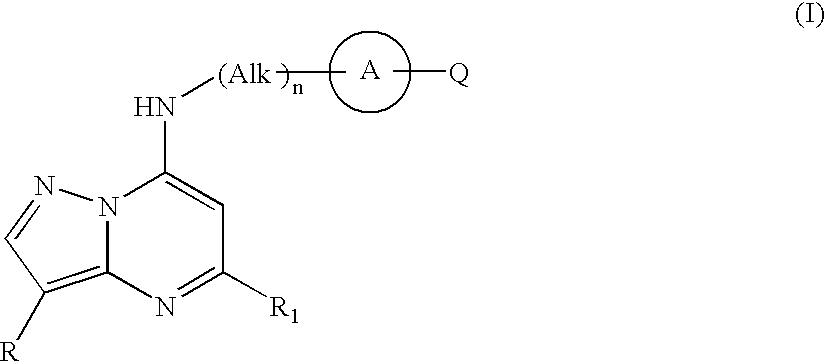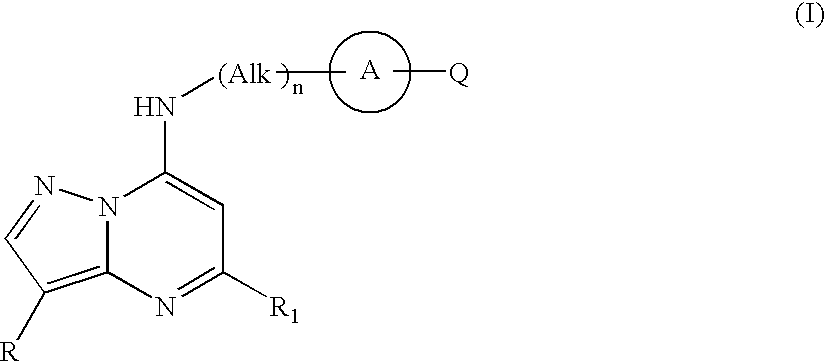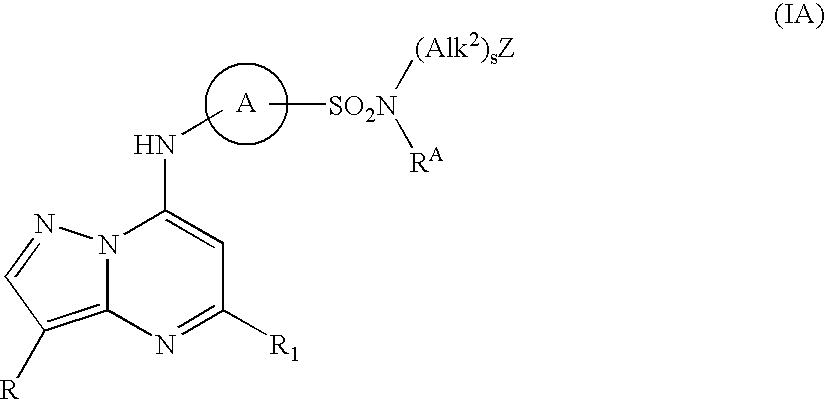Pyrazolopyrimidine compounds and their use in medicine
a technology of pyrazolopyrimidine and compounds, which is applied in the field of pyrazolopyrimidine compounds and their use in medicine, can solve the problems of inappropriate activation of pathways, cell cycle arrest, and certain cancer cells, but are less able to tolerate antisense-mediated reductions in pdk1 activity,
- Summary
- Abstract
- Description
- Claims
- Application Information
AI Technical Summary
Problems solved by technology
Method used
Image
Examples
example 1
[0070]
Step 1
5-Chloro-7-(4-fluorophenylamino)pyrazolo[1,5-a]pyrimidine
[0071] To a solution of 5,7-dichloropyrazolo[1,5-a]pyrimidine1 (0.35 g, 1.86 mmol) in ethanol (15 cm3) was added 4-fluoroaniline (0.35 cm3, 3.72 mmol). The reaction mixture was heated under reflux for 1 hour. The reaction mixture was concentrated in vacuo and the product purified on silica eluting with 15% ethyl acetate in hexanes, to yield the title compound as a white solid (0.42 g, 86%).
1. T. Novinson et al., Journal of Medicinal Chemistry (1976), 19(4), 512-16.
[0072]δH (400 MHz; d4-MeOH) 8.02 (1H, d, J 2.2 Hz), 7.40-7.36 (2H, m), 7.21 (2H, t, J 6.7), 6.32 (1H, d, J 2.2 Hz), 5.97 (1H, s). m / z 263 and 265 (each M+H, 100% and 30%) retention time 2.54 min (Method A).
Step 2
5-Chloro-7-(N-tert-butoxycarbonyl-4-fluorophenylamino)pyrazolo[1,5-a]pyrimidine
[0073] To a solution of 5-chloro-7-(4-fluorophenylamino)pyrazolo[1,5-a]pyrimidine (0.15 g, 0.57 mmol) in dichloromethane (10 cm3) was added di-tert-butyl dicarbo...
example 2
[0079]
5-(3,5-Dimethylisoxazole)-7-(4-fluorophenylamino)pyrazolo[1,5-a]pyrimidine
[0080] To a solution of 5-chloro-7-(N-tert-butoxycarbonyl-4-fluorophenylamino)pyrazolo[1,5-a]pyrimidine (Example 1, Step 2) (0.05 g, 0.14 mmol) in 1,4-dioxane (3.5 cm3) and water (1 cm3) was added 3,5-dimethylisoxazole-4-boronic acid (0.023 g, 0.16 mmol) and sodium carbonate (0.031 g, 0.29 mmol). The solution was degassed by bubbling nitrogen through the mixture for 5 min. Tetrakis(triphenylphosphine)palladium(0) (0.015 g, 0.012 mmol) was added to the mixture and the reaction heated at 150° C. for 10 min in a microwave oven. The reaction mixture was concentrated in vacuo and purified on silica eluting with 2% methanol in dichloromethane to yield the title compound as a white solid (0.021 g, 47%).
[0081]δH (400 MHz; d-CHCl3) 8.03 (1H, d, J 2.3 Hz), 7.97 (1H, s), 7.33-7.30 (2H, m), 7.13 (2H, t, J 8.5 Hz), 6.52 (1H, d, J 2.3 Hz), 6.13 (1H, s), 2.50 (3H, s), 2.34 (3H, s). m / z 324 (M+H, 100%), retention time...
examples 3-8
[0082] The compounds of Examples 3-8, listed in the following Table 1 were commercially available from BioFocus (BioFocus pic, Chesterford Park, Saffron Walden, Essex, CB10 1XL). The compounds of Examples 1 and 2 are also included in the Table. All compounds were tested for CDK2, CHK1 and PDK1 inhibitory activity in the assays described below in the Assay section. The result obtained in each case is given in the Table.
TABLE 1CDK2Chk1PDK1RTStructureExampleIC50(μM)IC50(μM)IC50(μM)m / z(min)16.09>200>200305 (M + H, 100%)2.68213.37>200>200324 (M + H, 100%)2.5131.6429.634.6380 and 382 (each M + H, 100%)2.3443.76>200>200303 (M + H, 100%)2.2053.96>200>200337 (M + H, 100%)2.4265.65>200>200303 (M + H, 100%)2.3277.19>200>200316 (M + H, 100%)2.0787.55>200>200337 (M + H, 100%)2.48
[0083] The compounds of Examples 9-23, listed in the following Table 2 were prepared by methods analogous to those of Example 1. All compounds were tested for CDK2, CHK1 and PDK1 inhibitory activity in the assays descr...
PUM
| Property | Measurement | Unit |
|---|---|---|
| temperature | aaaaa | aaaaa |
| volume | aaaaa | aaaaa |
| pH | aaaaa | aaaaa |
Abstract
Description
Claims
Application Information
 Login to View More
Login to View More - R&D
- Intellectual Property
- Life Sciences
- Materials
- Tech Scout
- Unparalleled Data Quality
- Higher Quality Content
- 60% Fewer Hallucinations
Browse by: Latest US Patents, China's latest patents, Technical Efficacy Thesaurus, Application Domain, Technology Topic, Popular Technical Reports.
© 2025 PatSnap. All rights reserved.Legal|Privacy policy|Modern Slavery Act Transparency Statement|Sitemap|About US| Contact US: help@patsnap.com



